Eliza Knight's Blog, page 12
June 21, 2016
Bold...Brilliant...Brave...Heroines Throughout History PETTICOAT SPIES ~ Part Two by Tara Kingston
Welcome back to History Undressed, our regular 3rd Tuesday blogger, Tara Kingston! Today she's bringing us Part Two of her Petticoat Spies article. The first can be viewed here. Enjoy!
Bold...Brilliant...Brave...Heroines Throughout HistoryPETTICOAT SPIES ~ Part Two
by Tara Kingston
Greetings! I’m Tara Kingston, historical romance author and lover of all things Victorian. I’m fascinated by history through the ages, especially the bold, brilliant women who helped shape our world, and I’m delighted to be a monthly contributor to History Undressed. I’ll be sharing facts about daring women through history—some famous, some not so well-known, but all remarkable with their own unique contributions.
Today’s post takes a look at several female spies of the Civil War era. Driven by fierce loyalty, women on both sides of the conflict faced incredible risks to gather intelligence that help defeat the enemy. This month, the focus is on some of brave women who spied for the Confederacy.
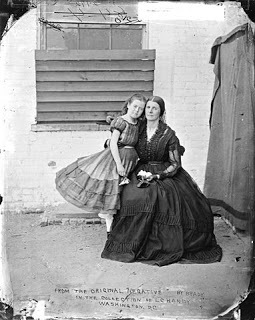
Rose O’Neal Greenhow ~ The widowed Washington, D.C. socialite known as “Rebel Rose” used her considerable connections to spy for the Confederacy. A charming hostess, Rebel Rose gleaned information on military activities and Washington’s defenses and passed this on to Confederate leadership. Her activities drew the suspicion of Allan Pinkerton, resulting in her house arrest and eventual confinement in the Old Capitol Prison for several months. Deported to the South, Mrs. Greenhow was sent on a diplomatic mission to Britain and France by Jefferson Davis. During her time in England, Mrs. Greenhow wrote and published her memoirs.
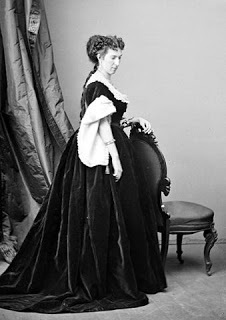
Belle Boyd ~ Born in West Virginia in 1844, Belle Boyd began spying for the Confederacy at the age of seventeen. Using her skill at flirtation to help her gather info, Belle served as a courier, passing information to Confederate generals such as Stonewall Jackson and P.G.T. Beauregard. The woman known as “Cleopatra of the Secession” and “Siren of the Shenandoah” was arrested on multiple occasions by Union forces and faced eventual imprisonment in the Old Capitol Prison. Following her release, Belle boarded a ship bound for England in 1864, intent on transporting Confederate papers. After the ship was intercepted by a Union Navy vessel, Belle was again arrested as a spy. She fell in love with a Union officer who was one of her captors, Samuel Hardinge; they later married and had a daughter. After the war, Belle Boyd wrote and published a memoir, Belle Boyd in Camp and Prison, and launched a career as an actress and performer, eventually touring the country giving lectures on her adventures as a Civil War spy.
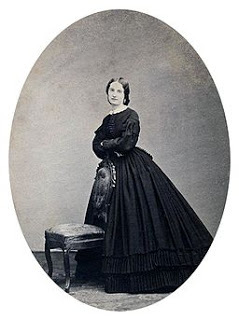
Antonia Ford Willard ~ Born in Virginia in 1838, Antonia Ford gathered information from occupying Union soldiers in her hometown, Fairfax Court House and provided military intelligence to Confederate general J.E.B. Stuart and spied for Colonel John Mosby, leader of a group of Confederate rangers. Miss Ford received an honorary commission as an aide-de-camp from Stuart in 1861. Accused of spying in 1863, Antonia Ford was arrested and held in the Old Capitol Prison. Her arresting officer, Major Joseph Willard, had lobbied for her release. After taking the Oath of Allegiance, Antonia was released from prison and went on to marry Major Willard. Their son later became the lieutenant governor of Virginia.

Petticoat spies like these courageous women inspired my Secrets & Spies series. The three books in the series are available for Kindle and Kindle Unlimited. Here’s a link to the first book in the series: Secrets, Spies & Sweet Little Lies on Kindle
Here’s a little about the story:
A heart's destiny cannot be denied when a daring Union spy abducts a beautiful runaway bride he suspects of being a traitor.
Emma Davenport was a model senator’s daughter: prim, proper, but hell-bent on escaping the dreaded fate of spinsterhood that awaited her under wartime Washington’s all-too watchful eye. She was going to be a bride, and no one was going to stop her. Not even the daring renegade who steals her from a train transporting her to a forbidden marriage. Her heart tells her this mysterious desperado is a dangerous man, but the pleasure of his touch is a more potent threat than any weapon.
Union Army Major Cole Travis is a highly trained operative, as skilled with deception as he is with a gun. Keeping a beautiful traitor from her rendezvous with a treacherous scoundrel shouldn’t be a challenge for the battle-seasoned spy—but he’s not the only one after his tempting captive. Emma Davenport must be kept out of enemy hands at all costs. Drawn to this woman whose innocent allure may be just another weapon in her arsenal, Cole risks his neck to shield her. Soon, however, protecting her from his own heart’s desire becomes another story entirely.
To Read More About Civil War Petticoat Spies:http://www.smithsonianmag.com/history/women-spies-of-the-civil-war-162202679/?no-ist https://www.nwhm.org/online-exhibits/spies/9.htmhttps://www.nps.gov/resources/person.htm?id=134http://www.biography.com/people/belle-boydwww.civilwar.org/education/history/biographies/maria-belle-boyd.htmlhttp://www.britannica.com/biography/Rose-ONeal-Greenhowhttp://www.civilwar.si.edu/leaders_greenhow.html
All photographs are in the public domain.
About The Author:
Award-winning author Tara Kingston writes historical romance laced with intrigue, danger, and adventures of the heart. A Southern belle-out-of-water in a quaint Pennsylvania town, she lives her own love story with her real-life hero in a cozy Victorian. The mother of two sons, Tara's a former librarian whose love of books is evident in her popping-at-the-seams bookcases. It goes without saying that Tara's husband is thankful for the invention of digital books, thereby eliminating the need for yet another set of shelves. When she's not writing, reading, or burning dinner, Tara enjoys cycling, hiking, and cheering on her favorite football team. Connect with Tara at www.tarakingston.com and on Facebook: https://www.facebook.com/AuthorTaraKingston
In a world where a man’s loyalty doesn’t depend on the color of a uniform, danger, intrigue, and passion are facts of life for the men and women of Tara’s Secrets & Spies series, historical romances set against the backdrop of the Civil War. http://www.amazon.com/gp/product/B00GK677PY/ref=series_rw_dp_sw
Bold...Brilliant...Brave...Heroines Throughout HistoryPETTICOAT SPIES ~ Part Two
by Tara Kingston
Greetings! I’m Tara Kingston, historical romance author and lover of all things Victorian. I’m fascinated by history through the ages, especially the bold, brilliant women who helped shape our world, and I’m delighted to be a monthly contributor to History Undressed. I’ll be sharing facts about daring women through history—some famous, some not so well-known, but all remarkable with their own unique contributions.
Today’s post takes a look at several female spies of the Civil War era. Driven by fierce loyalty, women on both sides of the conflict faced incredible risks to gather intelligence that help defeat the enemy. This month, the focus is on some of brave women who spied for the Confederacy.

Rose O’Neal Greenhow ~ The widowed Washington, D.C. socialite known as “Rebel Rose” used her considerable connections to spy for the Confederacy. A charming hostess, Rebel Rose gleaned information on military activities and Washington’s defenses and passed this on to Confederate leadership. Her activities drew the suspicion of Allan Pinkerton, resulting in her house arrest and eventual confinement in the Old Capitol Prison for several months. Deported to the South, Mrs. Greenhow was sent on a diplomatic mission to Britain and France by Jefferson Davis. During her time in England, Mrs. Greenhow wrote and published her memoirs.

Belle Boyd ~ Born in West Virginia in 1844, Belle Boyd began spying for the Confederacy at the age of seventeen. Using her skill at flirtation to help her gather info, Belle served as a courier, passing information to Confederate generals such as Stonewall Jackson and P.G.T. Beauregard. The woman known as “Cleopatra of the Secession” and “Siren of the Shenandoah” was arrested on multiple occasions by Union forces and faced eventual imprisonment in the Old Capitol Prison. Following her release, Belle boarded a ship bound for England in 1864, intent on transporting Confederate papers. After the ship was intercepted by a Union Navy vessel, Belle was again arrested as a spy. She fell in love with a Union officer who was one of her captors, Samuel Hardinge; they later married and had a daughter. After the war, Belle Boyd wrote and published a memoir, Belle Boyd in Camp and Prison, and launched a career as an actress and performer, eventually touring the country giving lectures on her adventures as a Civil War spy.

Antonia Ford Willard ~ Born in Virginia in 1838, Antonia Ford gathered information from occupying Union soldiers in her hometown, Fairfax Court House and provided military intelligence to Confederate general J.E.B. Stuart and spied for Colonel John Mosby, leader of a group of Confederate rangers. Miss Ford received an honorary commission as an aide-de-camp from Stuart in 1861. Accused of spying in 1863, Antonia Ford was arrested and held in the Old Capitol Prison. Her arresting officer, Major Joseph Willard, had lobbied for her release. After taking the Oath of Allegiance, Antonia was released from prison and went on to marry Major Willard. Their son later became the lieutenant governor of Virginia.

Petticoat spies like these courageous women inspired my Secrets & Spies series. The three books in the series are available for Kindle and Kindle Unlimited. Here’s a link to the first book in the series: Secrets, Spies & Sweet Little Lies on Kindle
Here’s a little about the story:
A heart's destiny cannot be denied when a daring Union spy abducts a beautiful runaway bride he suspects of being a traitor.
Emma Davenport was a model senator’s daughter: prim, proper, but hell-bent on escaping the dreaded fate of spinsterhood that awaited her under wartime Washington’s all-too watchful eye. She was going to be a bride, and no one was going to stop her. Not even the daring renegade who steals her from a train transporting her to a forbidden marriage. Her heart tells her this mysterious desperado is a dangerous man, but the pleasure of his touch is a more potent threat than any weapon.
Union Army Major Cole Travis is a highly trained operative, as skilled with deception as he is with a gun. Keeping a beautiful traitor from her rendezvous with a treacherous scoundrel shouldn’t be a challenge for the battle-seasoned spy—but he’s not the only one after his tempting captive. Emma Davenport must be kept out of enemy hands at all costs. Drawn to this woman whose innocent allure may be just another weapon in her arsenal, Cole risks his neck to shield her. Soon, however, protecting her from his own heart’s desire becomes another story entirely.
To Read More About Civil War Petticoat Spies:http://www.smithsonianmag.com/history/women-spies-of-the-civil-war-162202679/?no-ist https://www.nwhm.org/online-exhibits/spies/9.htmhttps://www.nps.gov/resources/person.htm?id=134http://www.biography.com/people/belle-boydwww.civilwar.org/education/history/biographies/maria-belle-boyd.htmlhttp://www.britannica.com/biography/Rose-ONeal-Greenhowhttp://www.civilwar.si.edu/leaders_greenhow.html
All photographs are in the public domain.
About The Author:
Award-winning author Tara Kingston writes historical romance laced with intrigue, danger, and adventures of the heart. A Southern belle-out-of-water in a quaint Pennsylvania town, she lives her own love story with her real-life hero in a cozy Victorian. The mother of two sons, Tara's a former librarian whose love of books is evident in her popping-at-the-seams bookcases. It goes without saying that Tara's husband is thankful for the invention of digital books, thereby eliminating the need for yet another set of shelves. When she's not writing, reading, or burning dinner, Tara enjoys cycling, hiking, and cheering on her favorite football team. Connect with Tara at www.tarakingston.com and on Facebook: https://www.facebook.com/AuthorTaraKingston
In a world where a man’s loyalty doesn’t depend on the color of a uniform, danger, intrigue, and passion are facts of life for the men and women of Tara’s Secrets & Spies series, historical romances set against the backdrop of the Civil War. http://www.amazon.com/gp/product/B00GK677PY/ref=series_rw_dp_sw
Published on June 21, 2016 05:23
June 15, 2016
Outlander Kitchen: My Review & a Featured Recipe!
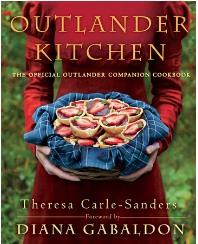
Happy Wednesday, friends! Yesterday saw the release of a cookbook, Outlander Kitchen by Theresa Carle-Sansders! I've been wanting to shout about! I had the pleasure of trying three of the recipes this past weekend at a party, and let me just say: all of them WINNERS! I was thrilled to be able to try a few of the recipes pre-release. See my pics and thoughts below!
Outlander Kitchen is a not to be missed cookbook for fans of the series, but also fans of really GOOD comfort foods (also, check out her blog!!!).
Here's a description of the book...
Take a bite out of Diana Gabaldon’s New York Timesbestselling Outlander novels, the inspiration for the hit Starz series, with this immersive official cookbook from OutlanderKitchen.com founder Theresa Carle-Sanders!
Claire Beauchamp Randall’s incredible journey from postwar Britain to eighteenth-century Scotland and France is a feast for all five senses, and taste is no exception. From Claire’s first lonely bowl of porridge at Castle Leoch to the decadent roast beef served after her hasty wedding to Highland warrior Jamie Fraser, from gypsy stew and jam tarts to fried chicken and buttermilk drop biscuits, there are enough mouth-watering meals along the way to whet the appetite of even the most demanding palate.
Now professional chef and founder of OutlanderKitchen.com Theresa Carle-Sanders offers up this extraordinary cuisine for your table. Featuring more than one hundred recipes, Outlander Kitchen retells Claire and Jamie’s incredible story through the flavors of the Scottish Highlands, the French Revolution, and beyond. Following the high standards for prodigious research and boundless creativity set by Diana Gabaldon herself, Carle-Sanders draws on the events and characters of the novels to deliver delicious and inventive dishes that highlight local ingredients and traditional cooking techniques. Yet amateur chefs need not fear: These doable, delectable recipes have been updated for today’s modern kitchens. Here are just a few of the dishes that will keep the world of Outlander on your mind morning, noon, and nicht:
• Breakfast: Yeasted Buckwheat Pancakes; A Coddled Egg for Duncan; Bacon, Asparagus, and Wild Mushroom Omelette• Appetizers: Cheese Savories; Rolls with Pigeons and Truffles; Beer-Battered Corn Fritters • Soups & Stocks: Cock-a-Leekie Soup; Murphy’s Beef Broth; Drunken Mock-Turtle Soup• Mains: Peppery Oyster Stew; Slow-Cooked Chicken Fricassee; Conspirators’ Cassoulet• Sides: Auld Ian’s Buttered Leeks; Matchstick Cold-Oil Fries; Honey-Roasted Butternut Squash• Bread & Baking: Pumpkin Seed and Herb Oatcakes; Fiona’s Cinnamon Scones; Jocasta’s Auld Country Bannocks• Sweets & Desserts: Black Jack Randall’s Dark Chocolate Lavender Fudge; Warm Almond Pastry with Father Anselm; Banoffee Trifle at River Run
With full-color photographs and plenty of extras—including cocktails, condiments, and preserves—Outlander Kitchen is an entertainment experience to savor, a wide-ranging culinary crash course, and a time machine all rolled into one. Forget bon appétit. As the Scots say, ith do leòr!
The party...
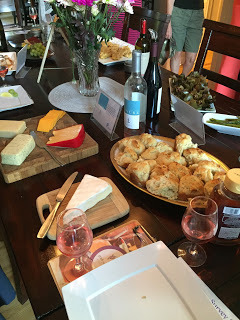
So, last Saturday, I was hosting a wine tasting party. Those who know me know I love WINE, and I love FOOD. I really enjoying cooking and hosting! (I have to give props to my oldest princess who was a HUGE help in preparing these recipes! She's 15. The recipes aren't complicated, but come off as though you've slaved for hours, which I'm cool with *winks*)
When I was approached by the author/chef and publisher, I thought it would be a great idea to try out a few of the recipes paired with wines and get a few opinions on the recipes from my guests.
We tried three of the recipes, Goat Cheese & Bacon Tarts, Apple Fritters and Mrs. Bug's Buttermilk Biscuits.
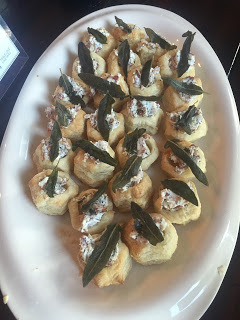
I'll start with the Goat Cheese & Bacon Tarts. These were FREAKING AMAZING! The recipe calls for puff pastry which you can buy in the store, or there is a recipe in the book. To save time, I actually used the puff pastry cups you can purchase in the frozen section.
These tarts were literally FILLED with flavor. We paired the tarts with a red zinfandel, but I thought it tasted equally good with a dry rose and darker red wine (pinotage from South Africa).
This was the one thing on the table that they didn't leave me any leftovers of!
The fried sage on top I think it was really brought the tarts together, too, and so many people were skeptical of eating the sage. But, frying it actually changed the usually strong, earthy flavor into an explosion of deliciousness. Plus, I love goat cheese, so, it was a win-win!
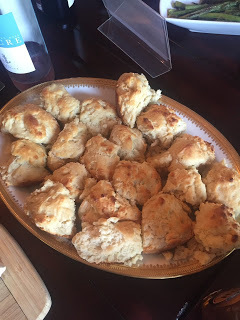
The next recipe we tried was Mrs. Bug's Buttermilk Biscuits! They were so freaking good--and I stole a couple from my guests to try the next day. Some biscuits don't last overnight. These DID. We had a biscuit connoisseur with us, and she said they were the best she'd ever had. They were moist, dense and made me want to curl up on my couch and re-watch The Wedding episode.
We paired the biscuits with cheese and a French dry rose. YUM!
When I tried them the next morning, I drizzled them with honey and sipped my coffee.
A versatile hunk of delicious carbs.
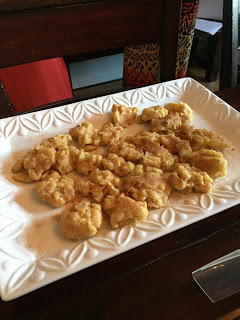
Onto the Apple Fritters! I am an apple fritter snob. When I was pregnant with princess #3 I tried apple fritters anywhere I could get them. That was my drug of choice. But when you buy a fritter normally, they aren't bite sized or filled with apples pre-soaked in Scotch Whisky. So, if you're looking for a grown up fritter--this is the way to go! Also, a note to you on frying -- the oil has to be the right temperature for the fritters not to fall apart. We used a cook thermometer to test the oil. (We dropped it in, hold on tight to it, lol). We paired these with a sparkling dessert wine. SO GOOD!
Featured Recipe...
Because the Goat Cheese & Bacon Tarts were the favorite of the party, I'm going to post the recipe below and insist you make them!!! Virtually no time at all. You defrost and pre-cook the pastry cups. If you're lazy about frying, like me, you bake you bacon at 425 in the oven fro 15-20 minutes. I was doing other stuff while waiting for the timer. Also, for "frying" the sage--I did that in the oven, too. I'm the worst fryer ever--see dropping thermometer into boiling oil above!
Goat Cheese and Bacon Tarts It was a savoury made of goat’s meat and bacon, and he saw Fergus’s prominent Adam’s apple bob in the slender throat at the smell of it. He knew they saved the best of the food for him; it didn’t take much looking at the pinched faces across the table. When he came, he brought what meat he could, snared rabbits or grouse, sometimes a nest of plover’s eggs—but it was never enough, for a house where hospitality must stretch to cover the needs of not only family and servants, but the families of the murdered Kirby and Murray. At least until spring, the widows and children of his tenants must bide here, and he must do his best to feed them. “Sit down by me,” he said to Jenny, taking her arm and gently guiding her to a seat on the bench beside him. She looked surprised—it was her habit to wait on him when he came—but sat down gladly enough. It was late, and she was tired; he could see the dark smudges beneath her eyes. —Voyager, chapter 4, “The Dunbonnet” Vegetarian options were tough to come by in the eighteenth century, and goat meat can be hard to find for some in the twenty-first, so I’m claiming food-from-fiction license with this switch-up from a meat pie to one-bite puff pastry rounds topped with a savory goat cheese spread. A delicious addition to the snack table at your next book club meeting or office party. Makes 36 Ingredients 4 slices thick-cut bacon, cut crosswise into ¼-inch strips ½ recipe Blitz Puff Pastry (page 29), chilled, or 1 pound (450 grams) frozen puff pastry, thawed 8 ounces (225 grams) goat cheese 1 tablespoon poppy seeds 3 tablespoons olive oil Zest of 1 lemon, grated or minced 1 large egg 2 tablespoons butter 36 small fresh sage leaves, or 18 large ones, cut in half lengthwise
Method Move a rack to the top-middle rung and heat the oven to 400°F. In a frying pan, crisp the bacon over medium heat. Drain on paper towels. On a lightly floured counter, roll the pastry out to a 16-inch square. Cover with plastic wrap and allow to rest for 10 minutes. Meanwhile, combine the goat cheese, bacon, poppy seeds, 1 tablespoon of the olive oil, and lemon zest in a small bowl and stir well. Cover and refrigerate. Lightly beat the egg with 1 teaspoon cold water to make an egg wash. Use a 3-inch round cutter to cut 36 rounds from the pastry. Transfer to a parchment paper–lined baking sheet and brush with the egg wash. Bake until puffed and golden, 12 to 15 minutes. Cool completely on the baking sheet. Reduce the oven to 300°F. In a small frying pan, heat the remaining 2 tablespoons olive oil and the butter until bubbling over medium heat. Fry the sage leaves in batches until crisp. Drain on a paper towel–lined plate and repeat with the remaining sage leaves. Top each puff pastry round with a teaspoonful of the goat cheese mixture and a fried sage leaf. Heat in the oven for 5 minutes and serve.
Published on June 15, 2016 06:15
June 14, 2016
Run Up the Signals - The Jolly Roger
Hoist the colors, mates!The Jolly Roger is known worldwide and as far back as the early 18th century as the flag of pirates. Thanks to movies and literature, the skull with crossed bones on a black flag is the standard ensign for pirates. But let’s take a closer look at pirate flags.
 Jolly Roger - What're you grinnin' 'bout?The Jolly Roger didn’t start out as a black flag with a skull and crossbones. Plain red or black flags were used prior to having the design. Plain red flags, also known as the bloody flag or the Red Jack, indicated bloodshed. Inventive, I know, but effective. Black was associated with death. Black flags were known to be flown on vessels affected by plague and served as a warning to other ships. See the correlation?
Jolly Roger - What're you grinnin' 'bout?The Jolly Roger didn’t start out as a black flag with a skull and crossbones. Plain red or black flags were used prior to having the design. Plain red flags, also known as the bloody flag or the Red Jack, indicated bloodshed. Inventive, I know, but effective. Black was associated with death. Black flags were known to be flown on vessels affected by plague and served as a warning to other ships. See the correlation?
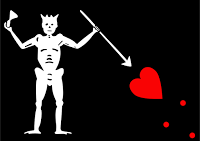 Blackbeard's flagThere are several theories for the term Jolly Roger but one is more widely recognized than the others. In the beginning, many early pirates were French buccaneers (hunters who slaughtered and smoked meat) turned pirate. Buccaneers’ original banners in the early 17th century just may have been their blood-splattered shirts. The French term joli rouge translates literally to pretty red. English speakers bastardized the words, as they often do, into Jolly Roger. In a roundabout way, it makes sense considering the English’s penchant for nicknames. We know that jolly means merry and festive and Roger is a generic term for a male person. Put together, Jolly Roger is a type of slang for fellow. It is suggested that the grinning skull(s) on the standards were satirically dubbed with the name Jolly Roger. Roger could also mean rogue or vagabond, and Old Roger was a reference to the devil. Seems Jolly Roger was an apt symbolic moniker for a pirate flag.
Blackbeard's flagThere are several theories for the term Jolly Roger but one is more widely recognized than the others. In the beginning, many early pirates were French buccaneers (hunters who slaughtered and smoked meat) turned pirate. Buccaneers’ original banners in the early 17th century just may have been their blood-splattered shirts. The French term joli rouge translates literally to pretty red. English speakers bastardized the words, as they often do, into Jolly Roger. In a roundabout way, it makes sense considering the English’s penchant for nicknames. We know that jolly means merry and festive and Roger is a generic term for a male person. Put together, Jolly Roger is a type of slang for fellow. It is suggested that the grinning skull(s) on the standards were satirically dubbed with the name Jolly Roger. Roger could also mean rogue or vagabond, and Old Roger was a reference to the devil. Seems Jolly Roger was an apt symbolic moniker for a pirate flag.
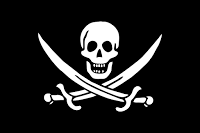 Jack Rackham's flagjovial
Jack Rackham's flagjovial
Throughout maritime history, flags were used to communicate to passing ships and those on shore, particularly the allegiance of country. Pirates were no different, except they claimed no allegiance to any country. Their flags carried a message, as well. One that struck fear into the hearts of sailors, soldiers, and commoners alike.
 Thomas Tew's flagSolid black flags gave their mark a chance to surrender without spilling blood. Remember, pirates would rather their prey surrender than go to battle. Battle meant lost of limb and life, and quite certainly damaging the targeted quarry or their own ship. And of course, combat was costly. Ammunitions wasn’t free...unless it was taken from the enemy.
Thomas Tew's flagSolid black flags gave their mark a chance to surrender without spilling blood. Remember, pirates would rather their prey surrender than go to battle. Battle meant lost of limb and life, and quite certainly damaging the targeted quarry or their own ship. And of course, combat was costly. Ammunitions wasn’t free...unless it was taken from the enemy.
But at the slightest resistance, pirates may swap out the black flag for a red one. The red flag instilled terror unlike any other. Once the Red Jack was hoisted, pirates meant to take the prize by force. More importantly, they meant to show no quarter, no mercy. No one would be spared.
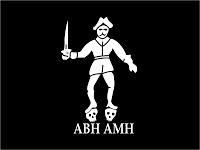 Black Bart's flagPirates had a collection of other flags from varying countries, too. While under sail, they often flew “false colors” or no flag at all. This was to protect their identities or trick other vessels until the opportune time. Flying flags from ally countries in waters frequently used as trade routes allowed pirates to get within firing range of their prey. At the point of no return, they might raise the Jolly Roger, sometimes at the same time as firing a warning shot.
Black Bart's flagPirates had a collection of other flags from varying countries, too. While under sail, they often flew “false colors” or no flag at all. This was to protect their identities or trick other vessels until the opportune time. Flying flags from ally countries in waters frequently used as trade routes allowed pirates to get within firing range of their prey. At the point of no return, they might raise the Jolly Roger, sometimes at the same time as firing a warning shot.
Before the adoption of the skull and crossbones, pirate flags evolved from solid colors to something more...personal. Many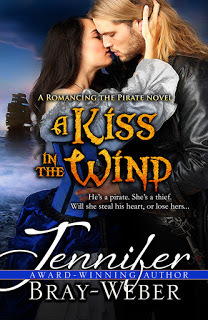 Beautiful thief + sexy libertine = wicked fun
Beautiful thief + sexy libertine = wicked fun
Click here for more!designs were from the imaginings of the pirate captains, themselves. Skeletons, swords, hourglasses, hearts—these were some of the widely used images meant to inspire a level of fear which gave pirates ultimate power. These insignias also identified who would be behind the horrors to come, what ghastly devil would be credited for the carnage should the victims be unlucky enough.
Once piracy became loosely organized crime during the Golden Age of Piracy with interconnecting brotherhoods, the skull and crossbones, along with the name Jolly Roger, replaced the diverse designs and became the accepted pirate flag we are familiar with today. Talk about the ultimate branding tool.
Appearances do matter. And the appearance of the Jolly Roger on the horizon meant trouble and would not be a welcome sight. Well, unless it was Captain Jack Sparrow at the helm.
About the Author
Jennifer is the award-winning author of the Romancing the Pirate series. Visit her at www.jbrayweber.com or join her mailing list for sneak peeks, excerpts, and giveaways.
 Jolly Roger - What're you grinnin' 'bout?The Jolly Roger didn’t start out as a black flag with a skull and crossbones. Plain red or black flags were used prior to having the design. Plain red flags, also known as the bloody flag or the Red Jack, indicated bloodshed. Inventive, I know, but effective. Black was associated with death. Black flags were known to be flown on vessels affected by plague and served as a warning to other ships. See the correlation?
Jolly Roger - What're you grinnin' 'bout?The Jolly Roger didn’t start out as a black flag with a skull and crossbones. Plain red or black flags were used prior to having the design. Plain red flags, also known as the bloody flag or the Red Jack, indicated bloodshed. Inventive, I know, but effective. Black was associated with death. Black flags were known to be flown on vessels affected by plague and served as a warning to other ships. See the correlation? Blackbeard's flagThere are several theories for the term Jolly Roger but one is more widely recognized than the others. In the beginning, many early pirates were French buccaneers (hunters who slaughtered and smoked meat) turned pirate. Buccaneers’ original banners in the early 17th century just may have been their blood-splattered shirts. The French term joli rouge translates literally to pretty red. English speakers bastardized the words, as they often do, into Jolly Roger. In a roundabout way, it makes sense considering the English’s penchant for nicknames. We know that jolly means merry and festive and Roger is a generic term for a male person. Put together, Jolly Roger is a type of slang for fellow. It is suggested that the grinning skull(s) on the standards were satirically dubbed with the name Jolly Roger. Roger could also mean rogue or vagabond, and Old Roger was a reference to the devil. Seems Jolly Roger was an apt symbolic moniker for a pirate flag.
Blackbeard's flagThere are several theories for the term Jolly Roger but one is more widely recognized than the others. In the beginning, many early pirates were French buccaneers (hunters who slaughtered and smoked meat) turned pirate. Buccaneers’ original banners in the early 17th century just may have been their blood-splattered shirts. The French term joli rouge translates literally to pretty red. English speakers bastardized the words, as they often do, into Jolly Roger. In a roundabout way, it makes sense considering the English’s penchant for nicknames. We know that jolly means merry and festive and Roger is a generic term for a male person. Put together, Jolly Roger is a type of slang for fellow. It is suggested that the grinning skull(s) on the standards were satirically dubbed with the name Jolly Roger. Roger could also mean rogue or vagabond, and Old Roger was a reference to the devil. Seems Jolly Roger was an apt symbolic moniker for a pirate flag.
 Jack Rackham's flagjovial
Jack Rackham's flagjovialThroughout maritime history, flags were used to communicate to passing ships and those on shore, particularly the allegiance of country. Pirates were no different, except they claimed no allegiance to any country. Their flags carried a message, as well. One that struck fear into the hearts of sailors, soldiers, and commoners alike.
 Thomas Tew's flagSolid black flags gave their mark a chance to surrender without spilling blood. Remember, pirates would rather their prey surrender than go to battle. Battle meant lost of limb and life, and quite certainly damaging the targeted quarry or their own ship. And of course, combat was costly. Ammunitions wasn’t free...unless it was taken from the enemy.
Thomas Tew's flagSolid black flags gave their mark a chance to surrender without spilling blood. Remember, pirates would rather their prey surrender than go to battle. Battle meant lost of limb and life, and quite certainly damaging the targeted quarry or their own ship. And of course, combat was costly. Ammunitions wasn’t free...unless it was taken from the enemy.But at the slightest resistance, pirates may swap out the black flag for a red one. The red flag instilled terror unlike any other. Once the Red Jack was hoisted, pirates meant to take the prize by force. More importantly, they meant to show no quarter, no mercy. No one would be spared.
 Black Bart's flagPirates had a collection of other flags from varying countries, too. While under sail, they often flew “false colors” or no flag at all. This was to protect their identities or trick other vessels until the opportune time. Flying flags from ally countries in waters frequently used as trade routes allowed pirates to get within firing range of their prey. At the point of no return, they might raise the Jolly Roger, sometimes at the same time as firing a warning shot.
Black Bart's flagPirates had a collection of other flags from varying countries, too. While under sail, they often flew “false colors” or no flag at all. This was to protect their identities or trick other vessels until the opportune time. Flying flags from ally countries in waters frequently used as trade routes allowed pirates to get within firing range of their prey. At the point of no return, they might raise the Jolly Roger, sometimes at the same time as firing a warning shot.Before the adoption of the skull and crossbones, pirate flags evolved from solid colors to something more...personal. Many
 Beautiful thief + sexy libertine = wicked fun
Beautiful thief + sexy libertine = wicked funClick here for more!designs were from the imaginings of the pirate captains, themselves. Skeletons, swords, hourglasses, hearts—these were some of the widely used images meant to inspire a level of fear which gave pirates ultimate power. These insignias also identified who would be behind the horrors to come, what ghastly devil would be credited for the carnage should the victims be unlucky enough.
Once piracy became loosely organized crime during the Golden Age of Piracy with interconnecting brotherhoods, the skull and crossbones, along with the name Jolly Roger, replaced the diverse designs and became the accepted pirate flag we are familiar with today. Talk about the ultimate branding tool.
Appearances do matter. And the appearance of the Jolly Roger on the horizon meant trouble and would not be a welcome sight. Well, unless it was Captain Jack Sparrow at the helm.
About the Author
Jennifer is the award-winning author of the Romancing the Pirate series. Visit her at www.jbrayweber.com or join her mailing list for sneak peeks, excerpts, and giveaways.
Published on June 14, 2016 01:30
June 8, 2016
When William the Conqueror Invaded Scotland by Regan Walker
Welcome to History Undressed, guest author, Regan Walker, author of historical romance! She's introducing us to William the Conqueror and when he invaded Scotland! Enjoy!
When William the Conqueror Invaded Scotland by Regan Walker
You might know that a Norman named William the Conqueror invaded England in 1066… but did you know that six years later, in 1072, he invaded Scotland? And not just with his army of knights that he dragged all over England, but with a fleet of ships!
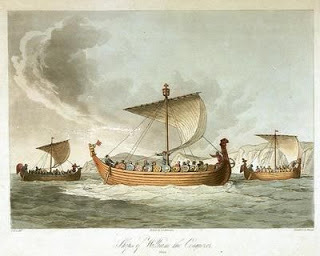
Steinar of Talisand, the hero in Rebel Warrior, my latest novel set in Scotland, belonged to that generation of young English men who were not yet twenty at the time of the Norman Conquest. They were old enough to understand what was happening and to feel keenly the loss of family and lands, yet powerless to do anything about it. Young Anglo-Saxon nobles forever exiled from their country.
Where should they go but to Scotland?
In the eleventh century, Scotland was a wild country where warlords vied for the throne, and the cultures of the Gaels (the Irish who became the Scots), Norse and eventually Saxons and Normans melded together. In 1057, Malcolm Canmore, the son of a king, battled his way to the throne to become King of Scots.
A decade later, William the Conqueror’s harsh actions in England sent Saxons in Wessex and Anglo-Scandinavians in Northumbria fleeing to Scotland. King Malcolm welcomed them and, in so doing, received a boon. For when he cast his eyes upon the beautiful Saxon Princess Margaret, whose family sought refuge at his court, he was smitten.

By 1072, when my story begins, they were married and she had already given him the first of six sons and two daughters.
That her rough, warrior husband deferred to her, at least in matters of their family, can be seen in the names given their sons: Edward, Edmund, Ethelred, Edgar, Alexander and David, the first four from the English royal dynasty. Perhaps, in agreeing to such names, Malcolm saw the potential for his sons to one day claim the throne of England, for as long as Margaret’s younger brother, Edgar Ætheling, the Saxon heir to the throne, remained unmarried and childless, his rights would be transmitted through Margaret to her children. Certainly William the Conqueror did not fail to note this.
At the time of my story, the borders between Scotland and England were not well defined. Malcolm often raided into Northumbria. That he had claims to the region cannot be doubted, but I believe he was also making a point to the Conqueror. It was a bit like poking a stick at a wild boar, however, for William would ultimately seek to rein in the powerful King of Scots and his support for the rebels in England.
The formal link between the royal houses of Scotland and Wessex and Malcolm’s forays into Northumbria were taken as a threat by William, who in 1072, counter-attacked with a full-scale invasion of southern Scotland, pursuing Malcolm into his own backyard.
Abbot Rivaux tells us that the Conqueror traversed Lothian and crossed the Forth by the Carse, the great gateway into Scotland. Florence of Worcester tells us that William penetrated to Abernethy, his fleet being in the River Tay.
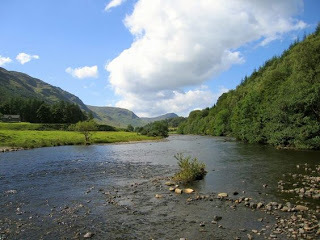
That William did not want war with the powerful King of Scots cannot be denied. Scotland was a bit too far and its mountains and lochs a bit too remote for even the Normans. If William was defeated, he could not hope to carry back his army into England. If Malcolm were beaten, the loss of battle might be to him the loss of his kingdom. This gives truth to the statements of the English chroniclers that a peace was agreed to at Abernethy, pursuant to which Malcolm’s lands in England were secured, he swore loyalty to William for those lands and, as a sign of good faith, sent Duncan, his oldest son by his first wife, Ingibiorg, back to England with William.
All this action and history is in Rebel Warrior.
Another likely condition of their peace at Abernethy was that the queen’s brother, Edgar Ætheling, was forced to leave Scotland. The presence of England’s heir in the court of so powerful a warrior as Malcolm had to be of concern to William. One reason Edgar’s sister, Margaret, agreed to wed Malcolm was to secure his support for Edgar’s claim to take back the throne of England.
Edgar did leave Scotland shortly after this. If you want to know when he returned, you’ll have to read my next novel to be released the fall, King’s Knight.
Rebel Warrior :
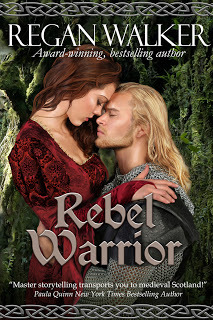
“Master storytelling transports you to medieval Scotland!” Paula Quinn, NY Times Bestselling Author
When your destiny lies far from where you began …
Scotland 1072
The Norman Conqueror robbed Steinar of Talisand of his noble father and his lands, forcing him to flee to Scotland while still recovering from a devastating wound. At the royal court, Steinar becomes scribe to the unlettered King of Scots while secretly regaining his skill with a sword.
The first time Steinar glimpses the flame-haired maiden, Catrìona of the Vale of Leven, he is drawn to her spirited beauty. She does not fit among the ladies who serve the devout queen. Not pious, not obedient and not given to stitchery, the firebrand flies a falcon! Though Catrìona captures Steinar’s attention, he is only a scribe and she is promised to another.
Catrìona has come to Malcolm’s court wounded in spirit from the vicious attack on her home by Northmen who slayed her parents and her people. But that is not all she will suffer. The man she thought to wed will soon betray her.
When all is lost, what hope is there for love? Can a broken heart be mended? Can a damaged soul be healed?
On Amazon: USUK
Regan’s WebsiteRegan’s blog, Historical Romance ReviewGoodreadsFacebook
Pinterest storyboard for RebelWarrior
Regan Walker is an award-winning, #1 bestselling author of Regency, Georgian and Medieval romances. She has five times been featured on USA TODAY's HEA blog and four times nominated for the prestigious RONE award (her novel, The Red Wolf's Prize won Best Historical Novel for 2015 in the medieval category). Regan writes historically authentic novels where history is a character and her readers experience adventure as well as love.
When William the Conqueror Invaded Scotland by Regan Walker
You might know that a Norman named William the Conqueror invaded England in 1066… but did you know that six years later, in 1072, he invaded Scotland? And not just with his army of knights that he dragged all over England, but with a fleet of ships!

Steinar of Talisand, the hero in Rebel Warrior, my latest novel set in Scotland, belonged to that generation of young English men who were not yet twenty at the time of the Norman Conquest. They were old enough to understand what was happening and to feel keenly the loss of family and lands, yet powerless to do anything about it. Young Anglo-Saxon nobles forever exiled from their country.
Where should they go but to Scotland?
In the eleventh century, Scotland was a wild country where warlords vied for the throne, and the cultures of the Gaels (the Irish who became the Scots), Norse and eventually Saxons and Normans melded together. In 1057, Malcolm Canmore, the son of a king, battled his way to the throne to become King of Scots.
A decade later, William the Conqueror’s harsh actions in England sent Saxons in Wessex and Anglo-Scandinavians in Northumbria fleeing to Scotland. King Malcolm welcomed them and, in so doing, received a boon. For when he cast his eyes upon the beautiful Saxon Princess Margaret, whose family sought refuge at his court, he was smitten.

By 1072, when my story begins, they were married and she had already given him the first of six sons and two daughters.
That her rough, warrior husband deferred to her, at least in matters of their family, can be seen in the names given their sons: Edward, Edmund, Ethelred, Edgar, Alexander and David, the first four from the English royal dynasty. Perhaps, in agreeing to such names, Malcolm saw the potential for his sons to one day claim the throne of England, for as long as Margaret’s younger brother, Edgar Ætheling, the Saxon heir to the throne, remained unmarried and childless, his rights would be transmitted through Margaret to her children. Certainly William the Conqueror did not fail to note this.
At the time of my story, the borders between Scotland and England were not well defined. Malcolm often raided into Northumbria. That he had claims to the region cannot be doubted, but I believe he was also making a point to the Conqueror. It was a bit like poking a stick at a wild boar, however, for William would ultimately seek to rein in the powerful King of Scots and his support for the rebels in England.
The formal link between the royal houses of Scotland and Wessex and Malcolm’s forays into Northumbria were taken as a threat by William, who in 1072, counter-attacked with a full-scale invasion of southern Scotland, pursuing Malcolm into his own backyard.
Abbot Rivaux tells us that the Conqueror traversed Lothian and crossed the Forth by the Carse, the great gateway into Scotland. Florence of Worcester tells us that William penetrated to Abernethy, his fleet being in the River Tay.

That William did not want war with the powerful King of Scots cannot be denied. Scotland was a bit too far and its mountains and lochs a bit too remote for even the Normans. If William was defeated, he could not hope to carry back his army into England. If Malcolm were beaten, the loss of battle might be to him the loss of his kingdom. This gives truth to the statements of the English chroniclers that a peace was agreed to at Abernethy, pursuant to which Malcolm’s lands in England were secured, he swore loyalty to William for those lands and, as a sign of good faith, sent Duncan, his oldest son by his first wife, Ingibiorg, back to England with William.
All this action and history is in Rebel Warrior.
Another likely condition of their peace at Abernethy was that the queen’s brother, Edgar Ætheling, was forced to leave Scotland. The presence of England’s heir in the court of so powerful a warrior as Malcolm had to be of concern to William. One reason Edgar’s sister, Margaret, agreed to wed Malcolm was to secure his support for Edgar’s claim to take back the throne of England.
Edgar did leave Scotland shortly after this. If you want to know when he returned, you’ll have to read my next novel to be released the fall, King’s Knight.
Rebel Warrior :

“Master storytelling transports you to medieval Scotland!” Paula Quinn, NY Times Bestselling Author
When your destiny lies far from where you began …
Scotland 1072
The Norman Conqueror robbed Steinar of Talisand of his noble father and his lands, forcing him to flee to Scotland while still recovering from a devastating wound. At the royal court, Steinar becomes scribe to the unlettered King of Scots while secretly regaining his skill with a sword.
The first time Steinar glimpses the flame-haired maiden, Catrìona of the Vale of Leven, he is drawn to her spirited beauty. She does not fit among the ladies who serve the devout queen. Not pious, not obedient and not given to stitchery, the firebrand flies a falcon! Though Catrìona captures Steinar’s attention, he is only a scribe and she is promised to another.
Catrìona has come to Malcolm’s court wounded in spirit from the vicious attack on her home by Northmen who slayed her parents and her people. But that is not all she will suffer. The man she thought to wed will soon betray her.
When all is lost, what hope is there for love? Can a broken heart be mended? Can a damaged soul be healed?
On Amazon: USUK
Regan’s WebsiteRegan’s blog, Historical Romance ReviewGoodreadsFacebook
Pinterest storyboard for RebelWarrior
Regan Walker is an award-winning, #1 bestselling author of Regency, Georgian and Medieval romances. She has five times been featured on USA TODAY's HEA blog and four times nominated for the prestigious RONE award (her novel, The Red Wolf's Prize won Best Historical Novel for 2015 in the medieval category). Regan writes historically authentic novels where history is a character and her readers experience adventure as well as love.
Published on June 08, 2016 00:00
June 7, 2016
A HUNGARIAN GYPSY, AN AMERICAN PRINCESS, AND A CAKE by Kathleen Bittner Roth
Welcome back to History Undressed, our regular first Tuesday blogger
and author, Kathleen Bittner Roth!
Kathleen Bittner Roth! Today she's got a fascinating and scandalicious article for us. Enjoy!
A HUNGARIAN GYPSY, AN AMERICAN PRINCESS, AND A CAKEBy Kathleen Bittner Roth
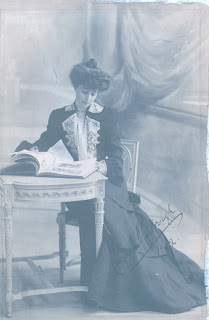
Clara Ward (1873-1916), born in Detroit to Michigan’s first millionaire, had a destiny unlike other American women. In 1889, Prince de Caraman-Chimay of Belgium toured the United States. He took one look at the very wealthy fourteen-year-old beauty and declared his love.
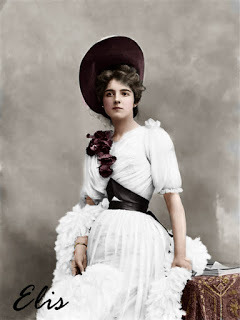
No matter that he was twice her age, had virtually no money in his princely coffers, and was of little consequence in the looks department, on May 19, 1890, fifteen-year-old Clara married the prince in Paris. Americans were ecstatic over their legitimate European princess, and the press went wild. Perhaps Clara, Princess of Chimay, as she preferred to be called, shouldn’t have married quite so young.
In early 1896, two years after the birth of her second daughter, Princess Clara and Prince de Caraman-Chimay were dining in an elegant Parisian restaurant when she met a dashing Hungarian musician by the name of Rigó Jancsi (Rigó was his family name. Jancsi means Johnny in Hungarian. To this day, Hungarians use this formal presentation of their names.)
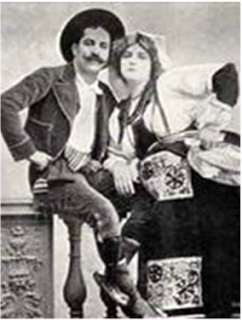
Rigó was a ruggedly handsome Gypsy violinist who began a series of secret meetings with the lovely Princess. In December of 1896, the two declared their love for one another and departed Paris for Budapest.
Prince Josef immediately began divorce proceedings. Once again, the press went wild with headlines screaming—Gone with the Gypsy!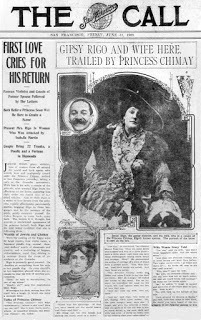
Rigó, a primis violinist, not only played for his new wife, one evening he ended up in the kitchen of their favorite Budapest restaurant where he helped to create a chocolate mousse sponge cake, a gift to his Belgian Princess. In honor of the romantic love story, the chef in collusion with Rigó named the cake Sutemeny Rigó Jancsi.
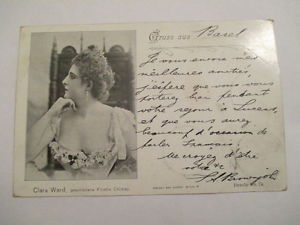
Unfortunately, Clara’s finances dwindled. With her greatest talents being her beauty and fame, while Rigó fiddled (on the violin and with other women) Clara took to the stage in Paris at the Moulin Rouge and Folies Bergère wearing skimpy outfits. She sold postcards and photographs in her skin tight, revealing clothing. Her outfits were so revealing, Kaiser Wilhelm II forbad the display of photographs bearing her likeness in the whole of the German Empire.
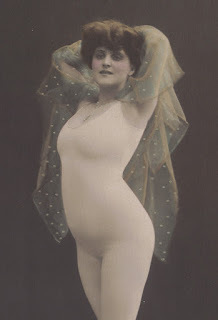
Clara divorced the cheating Rigó and married again, but the cake and her legacy live on. To this day, you can still find the cake, Sutemeny Rigó Jancsi, on restaurant menus in Budapest. And if you want the film version’s peek into the life of Clara Ward—Princess of Chimay—Cole Porter’s musical Can-Can was based on the Princess, and starred Shirley MacLaine as Pistache, dancing in a skin-tight, flesh-colored costume ala Clara Ward.
If you’d like to try the confection named in her honor, and you aren’t able to make the trek to Budapest (where this author currently resides), here’s the recipe:
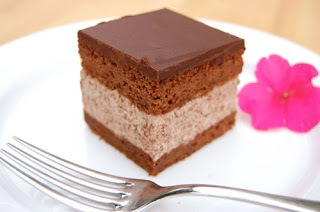
Sutemeny Rigó Jancsi Ingredients
Sponge Cake:
3 ounces unsweetened chocolate, melted and cooled to lukewarm3/4 cup (1 1/2 sticks) unsalted butter, softened1/4 cup plus 1/4 cup sugar4 eggs, separatedPinch salt1/2 cup all-purpose flourFilling:
1 1/2 cups heavy cream10 ounces semisweet chocolate, chopped4 tablespoons dark rum1 teaspoon vanilla extract Glaze:
7 ounces semisweet chocolate, chopped2 tablespoons unsalted butter2 tablespoons light corn syrup 1 teaspoon vanillaPreparationFor the cake: Heat oven to 350 degrees. Line a jellyroll pan with parchment paper. In a large bowl, cream 3/4 cup butter with 1/4 cup sugar until light and fluffy. Add cooled melted chocolate and beat in egg yolks one at a time.In a medium bowl, beat egg whites and pinch salt until whites cling to the beater. Add remaining 1/4 cup sugar and beat until stiff peaks form.Lighten the chocolate mixture by stirring in 1/3 of the whites. Then, carefully, fold in the remaining whites. Sprinkle the flour over the batter and, carefully, fold it in without decreasing the volume.Pour into prepared pan and bake 12-15 minutes, or until cake starts to pull away from the sides. Do not overbake. Cool a few minutes on a wire rack and then invert onto the rack. Remove parchment paper and let cool completely.For the filling: Meanwhile, Place 10 ounces chocolate in a heatproof bowl. Bring the cream to a boil in the microwave or on the stovetop and pour over chocolate. Cover with plastic wrap and let stand 10 minutes. Add rum and vanilla and stir until smooth. Refrigerate 1 hour. When cold, whip the filling until volume has doubled.Assembly: Cut the cake in half and place one half on a rack. Spread the filling over the cake and top with the remaining cake half. Refrigerate for 1 hour.For the glaze: Meanwhile, Place 7 ounces chocolate, butter and corn syrup in a microwaveable bowl. Heat on full power 1 minute. Add vanilla and stir until completely melted and smooth. Let cool 10 minutes.Set the rack holding the cake over a pan to catch drips. Holding the glaze 2 inches above the cake, pour the glaze evenly, using a spatula to cover the sides, if necessary. Refrigerate 20 minutes or until glaze is set.This cake is very rich. Cut into 5 by 7 rows for a total of 35 small squares. Refrigerate leftovers.
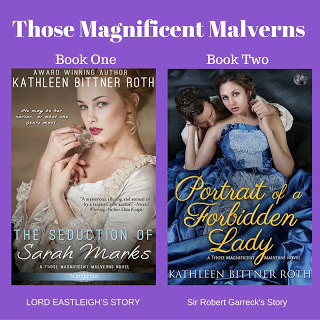
Kathleen Bittner Roth thrives on creating passionate stories featuring characters who are forced to draw on their strength of spirit to overcome adversity and find unending love. Her own fairy tale wedding in a Scottish castle led her to her current residence in Budapest, Hungary, considered one of Europe’s most romantic cities. However, she still keeps one boot firmly in Texas and the other in her home state of Minnesota. A member of Romance Writers of America®, she was a finalist in the prestigious Golden Heart® contest. Find Kathleen on Facebook, Goodreads, Twitter, Pinterest and www.kathleenbittnerroth.com.
PORTRAIT OF A FORBIDDEN LADY is book two in Those Magnificent Malverns series: A young widow returns to her childhood home after a forced absence and faces her first and only love, but despite their powerful attraction, danger compels her to remain his forbidden lady. ORDER YOUR COPY!
THE SEDUCTION OF SARAH MARKS is book one in Those Magnificent Malverns series: When a proper Victorian miss awakens next to a handsome stranger, she must rely on the man's benevolence as she struggles to regain her memory and hold onto her heart. ORDER YOUR COPY!
A HUNGARIAN GYPSY, AN AMERICAN PRINCESS, AND A CAKEBy Kathleen Bittner Roth

Clara Ward (1873-1916), born in Detroit to Michigan’s first millionaire, had a destiny unlike other American women. In 1889, Prince de Caraman-Chimay of Belgium toured the United States. He took one look at the very wealthy fourteen-year-old beauty and declared his love.

No matter that he was twice her age, had virtually no money in his princely coffers, and was of little consequence in the looks department, on May 19, 1890, fifteen-year-old Clara married the prince in Paris. Americans were ecstatic over their legitimate European princess, and the press went wild. Perhaps Clara, Princess of Chimay, as she preferred to be called, shouldn’t have married quite so young.
In early 1896, two years after the birth of her second daughter, Princess Clara and Prince de Caraman-Chimay were dining in an elegant Parisian restaurant when she met a dashing Hungarian musician by the name of Rigó Jancsi (Rigó was his family name. Jancsi means Johnny in Hungarian. To this day, Hungarians use this formal presentation of their names.)

Rigó was a ruggedly handsome Gypsy violinist who began a series of secret meetings with the lovely Princess. In December of 1896, the two declared their love for one another and departed Paris for Budapest.
Prince Josef immediately began divorce proceedings. Once again, the press went wild with headlines screaming—Gone with the Gypsy!

Rigó, a primis violinist, not only played for his new wife, one evening he ended up in the kitchen of their favorite Budapest restaurant where he helped to create a chocolate mousse sponge cake, a gift to his Belgian Princess. In honor of the romantic love story, the chef in collusion with Rigó named the cake Sutemeny Rigó Jancsi.

Unfortunately, Clara’s finances dwindled. With her greatest talents being her beauty and fame, while Rigó fiddled (on the violin and with other women) Clara took to the stage in Paris at the Moulin Rouge and Folies Bergère wearing skimpy outfits. She sold postcards and photographs in her skin tight, revealing clothing. Her outfits were so revealing, Kaiser Wilhelm II forbad the display of photographs bearing her likeness in the whole of the German Empire.

Clara divorced the cheating Rigó and married again, but the cake and her legacy live on. To this day, you can still find the cake, Sutemeny Rigó Jancsi, on restaurant menus in Budapest. And if you want the film version’s peek into the life of Clara Ward—Princess of Chimay—Cole Porter’s musical Can-Can was based on the Princess, and starred Shirley MacLaine as Pistache, dancing in a skin-tight, flesh-colored costume ala Clara Ward.
If you’d like to try the confection named in her honor, and you aren’t able to make the trek to Budapest (where this author currently resides), here’s the recipe:

Sutemeny Rigó Jancsi Ingredients
Sponge Cake:
3 ounces unsweetened chocolate, melted and cooled to lukewarm3/4 cup (1 1/2 sticks) unsalted butter, softened1/4 cup plus 1/4 cup sugar4 eggs, separatedPinch salt1/2 cup all-purpose flourFilling:
1 1/2 cups heavy cream10 ounces semisweet chocolate, chopped4 tablespoons dark rum1 teaspoon vanilla extract Glaze:
7 ounces semisweet chocolate, chopped2 tablespoons unsalted butter2 tablespoons light corn syrup 1 teaspoon vanillaPreparationFor the cake: Heat oven to 350 degrees. Line a jellyroll pan with parchment paper. In a large bowl, cream 3/4 cup butter with 1/4 cup sugar until light and fluffy. Add cooled melted chocolate and beat in egg yolks one at a time.In a medium bowl, beat egg whites and pinch salt until whites cling to the beater. Add remaining 1/4 cup sugar and beat until stiff peaks form.Lighten the chocolate mixture by stirring in 1/3 of the whites. Then, carefully, fold in the remaining whites. Sprinkle the flour over the batter and, carefully, fold it in without decreasing the volume.Pour into prepared pan and bake 12-15 minutes, or until cake starts to pull away from the sides. Do not overbake. Cool a few minutes on a wire rack and then invert onto the rack. Remove parchment paper and let cool completely.For the filling: Meanwhile, Place 10 ounces chocolate in a heatproof bowl. Bring the cream to a boil in the microwave or on the stovetop and pour over chocolate. Cover with plastic wrap and let stand 10 minutes. Add rum and vanilla and stir until smooth. Refrigerate 1 hour. When cold, whip the filling until volume has doubled.Assembly: Cut the cake in half and place one half on a rack. Spread the filling over the cake and top with the remaining cake half. Refrigerate for 1 hour.For the glaze: Meanwhile, Place 7 ounces chocolate, butter and corn syrup in a microwaveable bowl. Heat on full power 1 minute. Add vanilla and stir until completely melted and smooth. Let cool 10 minutes.Set the rack holding the cake over a pan to catch drips. Holding the glaze 2 inches above the cake, pour the glaze evenly, using a spatula to cover the sides, if necessary. Refrigerate 20 minutes or until glaze is set.This cake is very rich. Cut into 5 by 7 rows for a total of 35 small squares. Refrigerate leftovers.

Kathleen Bittner Roth thrives on creating passionate stories featuring characters who are forced to draw on their strength of spirit to overcome adversity and find unending love. Her own fairy tale wedding in a Scottish castle led her to her current residence in Budapest, Hungary, considered one of Europe’s most romantic cities. However, she still keeps one boot firmly in Texas and the other in her home state of Minnesota. A member of Romance Writers of America®, she was a finalist in the prestigious Golden Heart® contest. Find Kathleen on Facebook, Goodreads, Twitter, Pinterest and www.kathleenbittnerroth.com.
PORTRAIT OF A FORBIDDEN LADY is book two in Those Magnificent Malverns series: A young widow returns to her childhood home after a forced absence and faces her first and only love, but despite their powerful attraction, danger compels her to remain his forbidden lady. ORDER YOUR COPY!
THE SEDUCTION OF SARAH MARKS is book one in Those Magnificent Malverns series: When a proper Victorian miss awakens next to a handsome stranger, she must rely on the man's benevolence as she struggles to regain her memory and hold onto her heart. ORDER YOUR COPY!
Published on June 07, 2016 00:00
May 31, 2016
Video of the Week: What the Oregon Trail Looks Like Today
I was obsessed with the Oregon Trail when I was younger! Check out this video from the Smithsonian!
Published on May 31, 2016 05:51
May 30, 2016
Happy Memorial Day!
Today is Memorial Day. Do you know why we celebrate? Today we give thanks to those who serve(d) our country in order to keep us safe. Thank you.
Published on May 30, 2016 03:00
May 29, 2016
Happy Birthday John F. Kennedy!
Today is John F. Kennedy, the USA's 35th President's birthday. Below is a short bio of his life.
Check out Eliza Knight's New and Upcoming Releases!
Highlander UndoneTaken by the Highlander (in the Captured by a Celtic Warrior Anthology)Claimed by the Warrior
Check out Eliza Knight's New and Upcoming Releases!
Highlander UndoneTaken by the Highlander (in the Captured by a Celtic Warrior Anthology)Claimed by the Warrior
Published on May 29, 2016 03:00
May 24, 2016
Bold...Brilliant...Brave...Heroines Throughout History: PETTICOAT SPIES by Tara Kingston
Bold...Brilliant...Brave...Heroines Throughout HistoryPETTICOAT SPIES ~Tara KingstonGreetings! I’m Tara Kingston, historical romance author and lover of all things Victorian. I’m fascinated by history through the ages, especially the bold, brilliant women who helped shape our world, and I’m delighted to be a monthly contributor to History Undressed. I’ll be sharing facts about daring women through history—some famous, some not so well-known, but all remarkable with their own unique contributions.
Today’s post takes a look at several female spies of the Civil War era. Driven by fierce loyalty, women on both sides of the conflict faced incredible risks to gather intelligence that help defeat the enemy. This month, the focus is on some of brave women who spied for the Union.
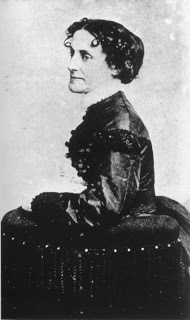
Elizabeth Van Lew ~ The true story of the Richmond, Virginia matron known as Crazy Bet was the inspiration for the cagy spymaster in Pistols, Parasols & Passionate Little Lies, the second book in my Secrets & Spies series. Abolitionist Elizabeth Van Lew capitalized on her eccentric personality while she operated a spy ring out of her Richmond home. While making visits to provide aid and food to Union prisoners at Libby Prison, she was able to funnel information to the inmates and aided those who managed to escape.
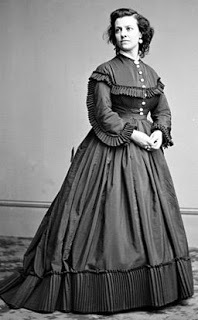
Pauline Cushman ~ Actress Pauline Cushman served as a Union spy behind enemy lines, using her charm and acting skills to gain access to intelligence. Caught with Confederate battle plans, she was tried and sentenced to hang, but narrowly escaped execution. After her rescue by Union forces, she was honored by President Lincoln and awarded the rank of Brevet-Major by General James Garfield.
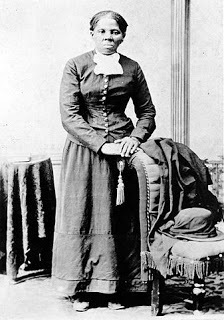
Harriet Tubman ~ The renowned Underground Railroad conductor served as a spy behind the Confederate line during the Civil War, establishing a spy network of former slaves. In 1863, she became the first American woman to lead a military expedition when she led a raid to free hundreds of slaves from rice plantations along the Combahee River in South Carolina.
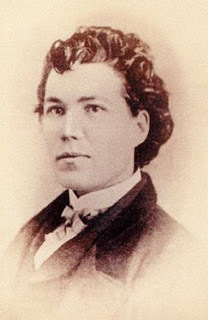
Sarah Emma Edmonds ~ Disguised as a man, Sarah Edmonds (under the alias Frank Thompson) enlisted in the 2nd Michigan Infantry as a male field nurse. She later is said to have served as a spy, infiltrating the Confederate Army behind enemy lines using a variety of disguises, including the persona of an Irish peddler named Bridget O’Shea and dyeing her skin with silver nitrate to affect the persona of a black man named Cuff.
Petticoat spies like these courageous women inspired my Secrets & Spies series. The first book in the series, Secrets, Spies & Sweet Little Lies, is on sale for Kindle until May 28 for only 99 cents! Here’s a link: Secrets, Spies & Sweet Little Lies on Kindle
Here’s a little about the story:
A heart's destiny cannot be denied when a daring Union spy abducts a beautiful runaway bride he suspects of being a traitor.
Emma Davenport was a model senator’s daughter: prim, proper, but hell-bent on escaping the dreaded fate of spinsterhood that awaited her under wartime Washington’s all-too watchful eye. She was going to be a bride, and no one was going to stop her. Not even the daring renegade who steals her from a train transporting her to a forbidden marriage. Her heart tells her this mysterious desperado is a dangerous man, but the pleasure of his touch is a more potent threat than any weapon.
Union Army Major Cole Travis is a highly trained operative, as skilled with deception as he is with a gun. Keeping a beautiful traitor from her rendezvous with a treacherous scoundrel shouldn’t be a challenge for the battle-seasoned spy—but he’s not the only one after his tempting captive. Emma Davenport must be kept out of enemy hands at all costs. Drawn to this woman whose innocent allure may be just another weapon in her arsenal, Cole risks his neck to shield her. Soon, however, protecting her from his own heart’s desire becomes another story entirely.
To Read More About Civil War Petticoat Spies:http://www.smithsonianmag.com/history/women-spies-of-the-civil-war-162202679/http://www.smithsonianmag.com/history/elizabeth-van-lew-an-unlikely-union-spy-158755584/?no-isthttps://www.nwhm.org/online-exhibits/spies/9.5.htmhttps://www.nwhm.org/online-exhibits/...https://www.nwhm.org/online-exhibits/spies/11.htmhttps://www.nps.gov/resources/person.htm?id=209http://www.biography.com/people/harriet-tubman-9511430http://www.biography.com/people/pauline-cushmanhttps://www.nps.gov/resources/person.... All photographs are in the public domain.
About The Author:
Award-winning author Tara Kingston writes historical romance laced with intrigue, danger, and adventures of the heart. A Southern belle-out-of-water in a quaint Pennsylvania town, she lives her own love story with her real-life hero in a cozy Victorian. The mother of two sons, Tara's a former librarian whose love of books is evident in her popping-at-the-seams bookcases. It goes without saying that Tara's husband is thankful for the invention of digital books, thereby eliminating the need for yet another set of shelves. When she's not writing, reading, or burning dinner, Tara enjoys cycling, hiking, and cheering on her favorite football team. Connect with Tara at www.tarakingston.com and on Facebook: https://www.facebook.com/AuthorTaraKingston
In a world where a man’s loyalty doesn’t depend on the color of a uniform, danger, intrigue, and passion are facts of life for the men and women of Tara’s Secrets & Spies series, historical romances set against the backdrop of the Civil War.http://www.amazon.com/gp/product/B00GK677PY/ref=series_rw_dp_sw
Today’s post takes a look at several female spies of the Civil War era. Driven by fierce loyalty, women on both sides of the conflict faced incredible risks to gather intelligence that help defeat the enemy. This month, the focus is on some of brave women who spied for the Union.

Elizabeth Van Lew ~ The true story of the Richmond, Virginia matron known as Crazy Bet was the inspiration for the cagy spymaster in Pistols, Parasols & Passionate Little Lies, the second book in my Secrets & Spies series. Abolitionist Elizabeth Van Lew capitalized on her eccentric personality while she operated a spy ring out of her Richmond home. While making visits to provide aid and food to Union prisoners at Libby Prison, she was able to funnel information to the inmates and aided those who managed to escape.

Pauline Cushman ~ Actress Pauline Cushman served as a Union spy behind enemy lines, using her charm and acting skills to gain access to intelligence. Caught with Confederate battle plans, she was tried and sentenced to hang, but narrowly escaped execution. After her rescue by Union forces, she was honored by President Lincoln and awarded the rank of Brevet-Major by General James Garfield.

Harriet Tubman ~ The renowned Underground Railroad conductor served as a spy behind the Confederate line during the Civil War, establishing a spy network of former slaves. In 1863, she became the first American woman to lead a military expedition when she led a raid to free hundreds of slaves from rice plantations along the Combahee River in South Carolina.

Sarah Emma Edmonds ~ Disguised as a man, Sarah Edmonds (under the alias Frank Thompson) enlisted in the 2nd Michigan Infantry as a male field nurse. She later is said to have served as a spy, infiltrating the Confederate Army behind enemy lines using a variety of disguises, including the persona of an Irish peddler named Bridget O’Shea and dyeing her skin with silver nitrate to affect the persona of a black man named Cuff.
Petticoat spies like these courageous women inspired my Secrets & Spies series. The first book in the series, Secrets, Spies & Sweet Little Lies, is on sale for Kindle until May 28 for only 99 cents! Here’s a link: Secrets, Spies & Sweet Little Lies on Kindle
Here’s a little about the story:
A heart's destiny cannot be denied when a daring Union spy abducts a beautiful runaway bride he suspects of being a traitor.
Emma Davenport was a model senator’s daughter: prim, proper, but hell-bent on escaping the dreaded fate of spinsterhood that awaited her under wartime Washington’s all-too watchful eye. She was going to be a bride, and no one was going to stop her. Not even the daring renegade who steals her from a train transporting her to a forbidden marriage. Her heart tells her this mysterious desperado is a dangerous man, but the pleasure of his touch is a more potent threat than any weapon.
Union Army Major Cole Travis is a highly trained operative, as skilled with deception as he is with a gun. Keeping a beautiful traitor from her rendezvous with a treacherous scoundrel shouldn’t be a challenge for the battle-seasoned spy—but he’s not the only one after his tempting captive. Emma Davenport must be kept out of enemy hands at all costs. Drawn to this woman whose innocent allure may be just another weapon in her arsenal, Cole risks his neck to shield her. Soon, however, protecting her from his own heart’s desire becomes another story entirely.
To Read More About Civil War Petticoat Spies:http://www.smithsonianmag.com/history/women-spies-of-the-civil-war-162202679/http://www.smithsonianmag.com/history/elizabeth-van-lew-an-unlikely-union-spy-158755584/?no-isthttps://www.nwhm.org/online-exhibits/spies/9.5.htmhttps://www.nwhm.org/online-exhibits/...https://www.nwhm.org/online-exhibits/spies/11.htmhttps://www.nps.gov/resources/person.htm?id=209http://www.biography.com/people/harriet-tubman-9511430http://www.biography.com/people/pauline-cushmanhttps://www.nps.gov/resources/person.... All photographs are in the public domain.
About The Author:
Award-winning author Tara Kingston writes historical romance laced with intrigue, danger, and adventures of the heart. A Southern belle-out-of-water in a quaint Pennsylvania town, she lives her own love story with her real-life hero in a cozy Victorian. The mother of two sons, Tara's a former librarian whose love of books is evident in her popping-at-the-seams bookcases. It goes without saying that Tara's husband is thankful for the invention of digital books, thereby eliminating the need for yet another set of shelves. When she's not writing, reading, or burning dinner, Tara enjoys cycling, hiking, and cheering on her favorite football team. Connect with Tara at www.tarakingston.com and on Facebook: https://www.facebook.com/AuthorTaraKingston
In a world where a man’s loyalty doesn’t depend on the color of a uniform, danger, intrigue, and passion are facts of life for the men and women of Tara’s Secrets & Spies series, historical romances set against the backdrop of the Civil War.http://www.amazon.com/gp/product/B00GK677PY/ref=series_rw_dp_sw
Published on May 24, 2016 06:04
May 10, 2016
The Big Guns
Pirate ships were well equipped with weaponry. For any ship worth its reputation, shipboard guns were an important part of the arsenal. It was these guns that waged war, won battles, and kept crews alive. But they were more complex than just cannons that go boom.
The basics:
First and foremost, cannons were not cannons aboard a ship. They were called guns. And the projectiles they fired were not cannon balls, rather they were shot. Guns were made from cast iron or sometimes bronze. Iron guns were subjected to corrosion from saltwater causing misfires or the lodging of the shot. Bronze guns were expensive to make. The longer the barrel of the gun, the farther it fired. Well, sort of, since the farther the distance the greater the inaccuracy. The guns could weigh anywhere from a few hundred pounds to several tons. Smaller guns, such as swivel guns, could be fastened to the ship, but the larger guns were mounted on wooden carriages. These big guns were identified by the weight of the shot they were made for. It was common for ships to carry 8-pounders, 12-pounders, 24-pounders, 36-pounders, and higher. There are a variety of small calibers, too.
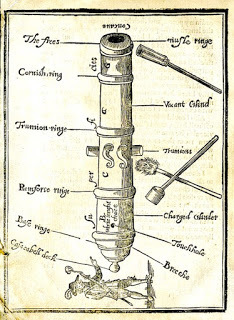 Parts of a shipboard gunThose suckers on carriages were big, weighed a ton (literally), and were dangerous. Smooth sailing did not apply with guns on board. They had to be lashed down to prevent rolling. Gun tackle (ropes) were tied to both sides of the carriage. In addition, a breeching rope was tied to the knob at the rear of the gun (called a cascabel) and fastened to the ship’s hull (wall). The breeching rope gave way just enough for loading. It also helped prevent the gun from recoiling with such force to snap the lashing ropes – a term called jumping its track. More rope was used to pull the gun up to the gun port. This rope, known as the train tackle, was attached to an eyebolt below the cascabel.
Parts of a shipboard gunThose suckers on carriages were big, weighed a ton (literally), and were dangerous. Smooth sailing did not apply with guns on board. They had to be lashed down to prevent rolling. Gun tackle (ropes) were tied to both sides of the carriage. In addition, a breeching rope was tied to the knob at the rear of the gun (called a cascabel) and fastened to the ship’s hull (wall). The breeching rope gave way just enough for loading. It also helped prevent the gun from recoiling with such force to snap the lashing ropes – a term called jumping its track. More rope was used to pull the gun up to the gun port. This rope, known as the train tackle, was attached to an eyebolt below the cascabel.
It takes a team:
Seriously, it took four to five men per gun working in synchronicity to fire. Men had assigned guns which totally makes sense when avoiding additional chaos in the heat of battle. After the gun was unlashed, hauled inward, the gun ports opened, and the equipment used for priming and loading were in hand, the real work commenced.The gun’s barrel was swabbed with a wet sponger rod to remove residue or embers. Loose, measured gunpowder went in first using a scooped powder ladle. Gunpowder might also come wrapped in Beautiful thief + sexy libertine = wicked fun
Beautiful thief + sexy libertine = wicked fun
Click here for more!cloth. Once the gunpowder was in, it was followed by a cloth, paper, or sometimes hay wad, packed in using a ramrod. Shot and another wad (to prevent the shot from rolling out) were rammed in next. A priming iron was used to clear the touchhole of residue and, if using a cartridge charge, pricked open the charge to expose gunpowder. The touchhole was filled with more gunpowder. The men adjusted the gun’s height using a quoin—a wooden wedge with notches on the carriage. A two to three-foot lintstock with a slow burning match was then set near enough to the touchhole to ignite the powder. Bam! A good gun crew familiar with their weapon could swab, load, aim, and fire a gun within two to five minutes. Huzzah, ye sea dogs!
Types of shot:
Aside from spherical balls of varying size and weight, pirates (and naval crews) were creative in their deadly projectiles.bar shot - two balls affixed at the ends of an iron bar (effective for maximum damage on men and rigging)chain shot - two balls affixed at each end of a chain (also effective in destroying rigging and sails)double shot - two balls with extra gunpowder in one gungrape shot - small iron balls wrapped in canvas (think buckshot, lots of balls taking out more than one target, be it human or other objects)langrage - canisters filled with scrap metal, nails, bolts, and even eating utensils (another impressive way to annihilate crew and rigging)partridge shot - small bags filled with pellets of lead (excellent for saturating an area)trundle shot - iron spikes or sharpened bars (good for impaling)
And these are just what was used in the guns. Weapons used by pirates were extensive—a topic for another post.
About the Author
Jennifer is the award-winning author of the Romancing the Pirate series. Visit her at www.jbrayweber.com or join her mailing list for sneak peeks, excerpts, and giveaways.
The basics:
First and foremost, cannons were not cannons aboard a ship. They were called guns. And the projectiles they fired were not cannon balls, rather they were shot. Guns were made from cast iron or sometimes bronze. Iron guns were subjected to corrosion from saltwater causing misfires or the lodging of the shot. Bronze guns were expensive to make. The longer the barrel of the gun, the farther it fired. Well, sort of, since the farther the distance the greater the inaccuracy. The guns could weigh anywhere from a few hundred pounds to several tons. Smaller guns, such as swivel guns, could be fastened to the ship, but the larger guns were mounted on wooden carriages. These big guns were identified by the weight of the shot they were made for. It was common for ships to carry 8-pounders, 12-pounders, 24-pounders, 36-pounders, and higher. There are a variety of small calibers, too.
 Parts of a shipboard gunThose suckers on carriages were big, weighed a ton (literally), and were dangerous. Smooth sailing did not apply with guns on board. They had to be lashed down to prevent rolling. Gun tackle (ropes) were tied to both sides of the carriage. In addition, a breeching rope was tied to the knob at the rear of the gun (called a cascabel) and fastened to the ship’s hull (wall). The breeching rope gave way just enough for loading. It also helped prevent the gun from recoiling with such force to snap the lashing ropes – a term called jumping its track. More rope was used to pull the gun up to the gun port. This rope, known as the train tackle, was attached to an eyebolt below the cascabel.
Parts of a shipboard gunThose suckers on carriages were big, weighed a ton (literally), and were dangerous. Smooth sailing did not apply with guns on board. They had to be lashed down to prevent rolling. Gun tackle (ropes) were tied to both sides of the carriage. In addition, a breeching rope was tied to the knob at the rear of the gun (called a cascabel) and fastened to the ship’s hull (wall). The breeching rope gave way just enough for loading. It also helped prevent the gun from recoiling with such force to snap the lashing ropes – a term called jumping its track. More rope was used to pull the gun up to the gun port. This rope, known as the train tackle, was attached to an eyebolt below the cascabel.It takes a team:
Seriously, it took four to five men per gun working in synchronicity to fire. Men had assigned guns which totally makes sense when avoiding additional chaos in the heat of battle. After the gun was unlashed, hauled inward, the gun ports opened, and the equipment used for priming and loading were in hand, the real work commenced.The gun’s barrel was swabbed with a wet sponger rod to remove residue or embers. Loose, measured gunpowder went in first using a scooped powder ladle. Gunpowder might also come wrapped in
 Beautiful thief + sexy libertine = wicked fun
Beautiful thief + sexy libertine = wicked funClick here for more!cloth. Once the gunpowder was in, it was followed by a cloth, paper, or sometimes hay wad, packed in using a ramrod. Shot and another wad (to prevent the shot from rolling out) were rammed in next. A priming iron was used to clear the touchhole of residue and, if using a cartridge charge, pricked open the charge to expose gunpowder. The touchhole was filled with more gunpowder. The men adjusted the gun’s height using a quoin—a wooden wedge with notches on the carriage. A two to three-foot lintstock with a slow burning match was then set near enough to the touchhole to ignite the powder. Bam! A good gun crew familiar with their weapon could swab, load, aim, and fire a gun within two to five minutes. Huzzah, ye sea dogs!
Types of shot:
Aside from spherical balls of varying size and weight, pirates (and naval crews) were creative in their deadly projectiles.bar shot - two balls affixed at the ends of an iron bar (effective for maximum damage on men and rigging)chain shot - two balls affixed at each end of a chain (also effective in destroying rigging and sails)double shot - two balls with extra gunpowder in one gungrape shot - small iron balls wrapped in canvas (think buckshot, lots of balls taking out more than one target, be it human or other objects)langrage - canisters filled with scrap metal, nails, bolts, and even eating utensils (another impressive way to annihilate crew and rigging)partridge shot - small bags filled with pellets of lead (excellent for saturating an area)trundle shot - iron spikes or sharpened bars (good for impaling)
And these are just what was used in the guns. Weapons used by pirates were extensive—a topic for another post.
About the Author
Jennifer is the award-winning author of the Romancing the Pirate series. Visit her at www.jbrayweber.com or join her mailing list for sneak peeks, excerpts, and giveaways.
Published on May 10, 2016 01:30



